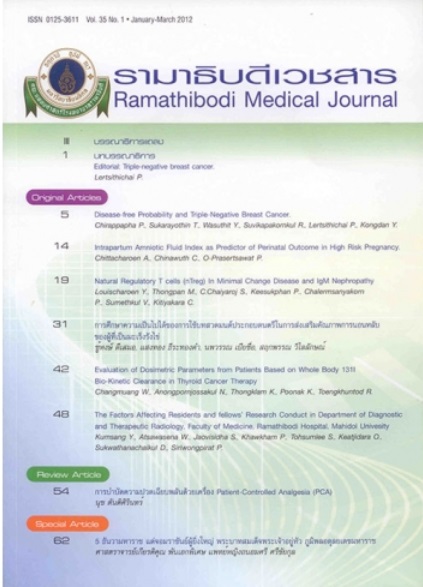Evaluation of Dosimetric Parameters from Patients Based on Whole Body 131 I Bio-Kinetic Clearance in Thyroid Cancer Therapy
Main Article Content
Abstract
Objective: The study was designed to evaluate the bio-kinetic clearance of radioactive iodine (131l) in the well-differentiated thyroid carcinoma patients treated with 1.11 GBq and to calculate organs and whole body absorbed dose with MIRDOSE3.1 computer software.
Materials and Methods: The whole body retention/excretion of 131l in all patients was determined individually by using gamma camera with high-energy general all purpose (HEGP) at the specific time points after its administration.
Results: The effective half-live (T eff) was estimated from the generated time-activity curves. The mean for effective half-life from whole body clearance curve was 26.2 ± 10.8 hours. The calculated residence time (t) was 38.0 ± 15.6 hours. The retained activity of 131l at 4, 24, 48, 72 and 144 hours was 77.8 ± 11.4, 44.4 ± 13.9, 23.8 ± 12.4, 13.3 ± 9.1 and 2.7 ± 2.6%, respectively. The mean for absorbed doses to whole body was 0.10 (0.04 mGy/MBq). The highest organ dose was uterus (0.11 ± 0.05 mGy/MBq). The mean for effective dose was 0.11 ± 0.04 mSv/MBq.
Conclusion: Retention and clearance rates of 131l could be obtained by in vivo measurements in individual patients. Evaluations of the Teff are essential parameter for absorbed dose calculation to patient and minimize the risk of external radiation exposure to staffs of nuclear medicine, family member and the public. These parameters are essential for management in thyroid cancer therapy, for both in patients and outpatients. Additionally, our parameters could be a useful parameter to develop the guideline for occupational and public radiation protection.
Article Details
References
Willegaignon J, Malvestiti L, Guimarães M, Sapienza M, Endo I, Neto G, et al. 131l effective half-life (T-eff) for patients with thyroid cancer. Health Physics. 91(2):119-22. doi:10.1097/01.HP.0000202232.98823.87.
International Commission on Radiological Protection. Release of Patients after Therapy with Unsealed Radionuclides. ICRP Publication 94. Ann ICRP. 2004;34(2):v-vi, 1-79. doi:10.1016/j.icrp.2004.08.001.
United Nations Scientific Committee on the Effects of Atomic Radiation. Sources and Effects of Ionizing Radiation: UNSCEAR 2000 Report to the General Assembly, with Scientific Annexes. New York : United Nations; 2000.
Brill AB, Stabin M, Bouville A, Ron E. Normal organ radiation dosimetry and associated uncertainties in nuclear medicine, with emphasis on iodine-131. Radiat Res. 2006;166(1 Pt 2):128-40. doi:10.1667/RR3558.1.
Stabin MG, Siegel JA. Physical models and dose factors for use in internal dose assessment. Health Phys. 2003;85(3):294-310. doi:10.1097/00004032-200309000-00006.
Stabin MG, Sparks RB, Crowe E. OLINDA/EXM: the second-generation personal computer software for internal dose assessment in nuclear medicine. J Nucl Med. 2005;46(6):1023-7.
Changlai SP, Chang PJ, Chen CY. Biodistribution and dosimetry of (131)I in thyroidectomy patients using semiquantitative gamma-camera imaging. Cancer Biother Radiopharm. 2008;23(6):759-66. doi:10.1089/cbr.2008.0488.
Nascimento AC, Lipsztein JL, Corbo R, Rebelo AM. 131I Biokinetics and cytogenetic dose estimates in ablation treatment of thyroid carcinoma. Health Phys. 2010;99(4):457-63. doi:10.1097/HP.0b013e3181c8f9ea.
Chen CY, Chang PJ, Changlai SP, Pan LK. Effective half life of iodine for five thyroidectomy patients using an in vivo gamma camera approach. J Radiat Res. 2007;48(6):485-93. doi:10.1269/jrr.07031.
U.S. Nuclear Regulatory Commission. Release of Patients Administered Radioactive Materials: Regulatory Guide 8.39. Washington, DC: U.S. Government Printing Office; 1997.
